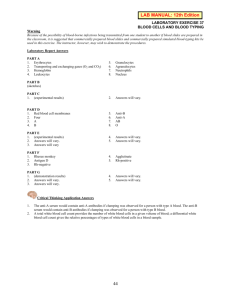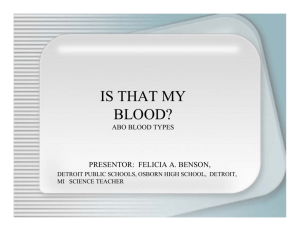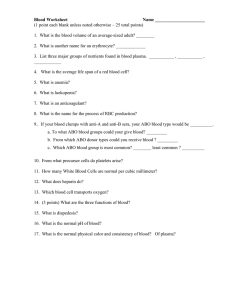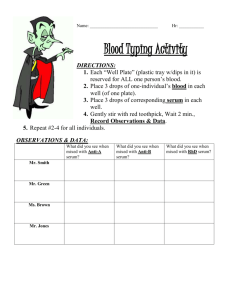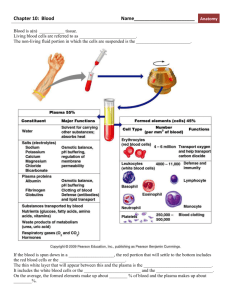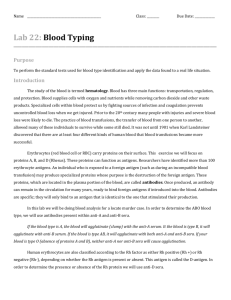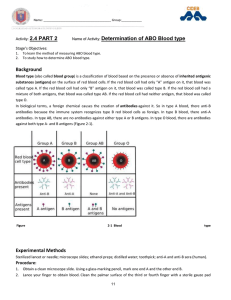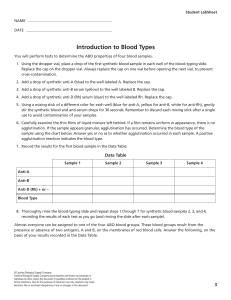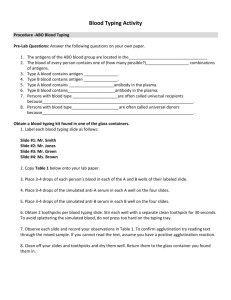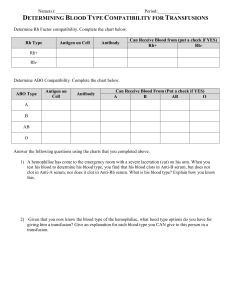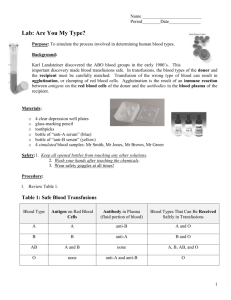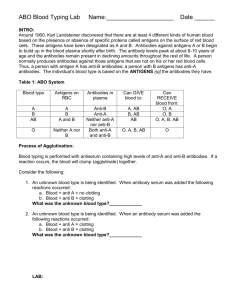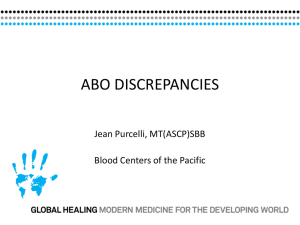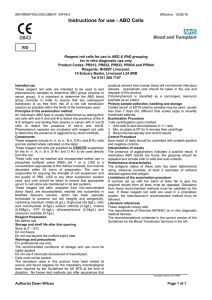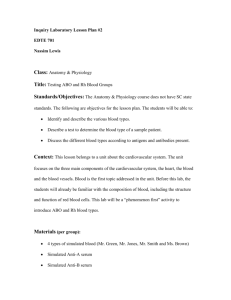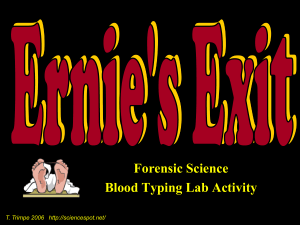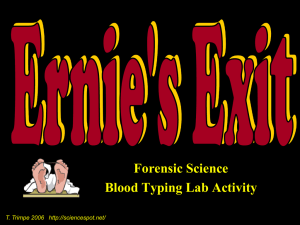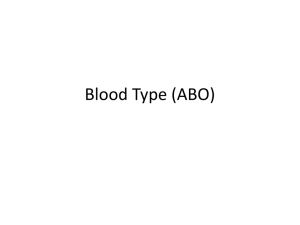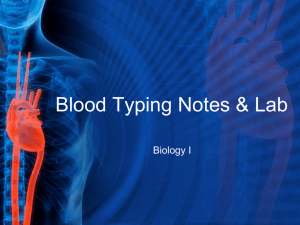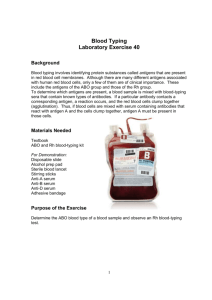Blood Typing lab
advertisement
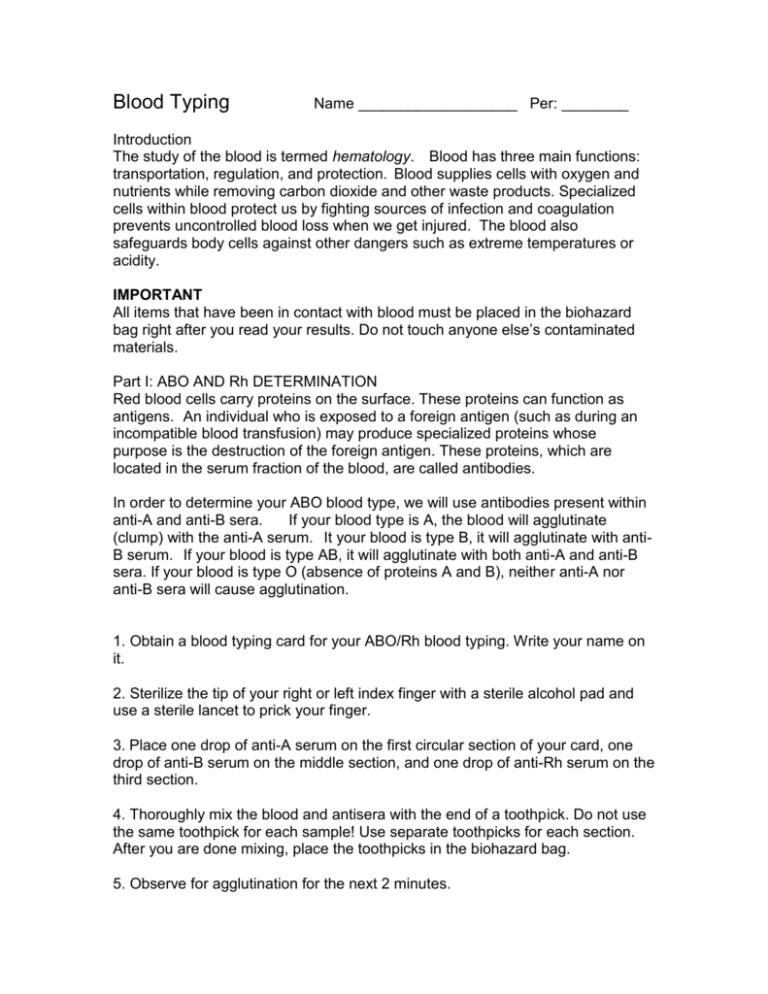
Blood Typing Name ___________________ Per: ________ Introduction The study of the blood is termed hematology. Blood has three main functions: transportation, regulation, and protection. Blood supplies cells with oxygen and nutrients while removing carbon dioxide and other waste products. Specialized cells within blood protect us by fighting sources of infection and coagulation prevents uncontrolled blood loss when we get injured. The blood also safeguards body cells against other dangers such as extreme temperatures or acidity. IMPORTANT All items that have been in contact with blood must be placed in the biohazard bag right after you read your results. Do not touch anyone else’s contaminated materials. Part I: ABO AND Rh DETERMINATION Red blood cells carry proteins on the surface. These proteins can function as antigens. An individual who is exposed to a foreign antigen (such as during an incompatible blood transfusion) may produce specialized proteins whose purpose is the destruction of the foreign antigen. These proteins, which are located in the serum fraction of the blood, are called antibodies. In order to determine your ABO blood type, we will use antibodies present within anti-A and anti-B sera. If your blood type is A, the blood will agglutinate (clump) with the anti-A serum. It your blood is type B, it will agglutinate with antiB serum. If your blood is type AB, it will agglutinate with both anti-A and anti-B sera. If your blood is type O (absence of proteins A and B), neither anti-A nor anti-B sera will cause agglutination. 1. Obtain a blood typing card for your ABO/Rh blood typing. Write your name on it. 2. Sterilize the tip of your right or left index finger with a sterile alcohol pad and use a sterile lancet to prick your finger. 3. Place one drop of anti-A serum on the first circular section of your card, one drop of anti-B serum on the middle section, and one drop of anti-Rh serum on the third section. 4. Thoroughly mix the blood and antisera with the end of a toothpick. Do not use the same toothpick for each sample! Use separate toothpicks for each section. After you are done mixing, place the toothpicks in the biohazard bag. 5. Observe for agglutination for the next 2 minutes. 6. Based on your observations, determine your ABO/Rh blood type and record your results below. (1 pt) Blood type ___________ Questions: 1. What antigens are present on a person’s red blood cells if that person is: (6 pts) (a) type B+ _______________________________ (b) type O- _______________________________ (c) type AB+______________________________ 2. Explain the danger of giving a person with type B a blood a transfusion with type A blood. (5 pts) 3. In a paternity suit, a woman (type O+) accuses a man (type A+) of being the father of her baby (type O+). Will the blood types prove or disprove her claim? Explain. (5 pts) 4. What blood types can Type A blood: a. Receive? ____________________________________________________ b. Donate to?___________________________________________________ 5. What blood types can Type B blood: a. Receive? ____________________________________________________ b. Donate to?___________________________________________________ 6. What blood types can Type AB blood: a. Receive? ____________________________________________________ b. Donate to?___________________________________________________ 7. What blood types can Type O blood: a. Receive? ____________________________________________________ b. Donate to?___________________________________________________ 8. Which blood type can give to ALL other blood types and is known as the UNIVERSAL DONOR? _______________________________________________________________ 9. Which blood type can receive blood from all other blood types and is known as the UNIVERSAL RECIPIENT? _________________________________________________ 10. What are the 4 main components of blood? ________________________________________________________________ 11. Which of these 4 parts determine a person’s blood type? ________________________________________________________________ 12. Make a table and a bar graph showing the different blood types of all of the students in this science class. (15pts) Include table and graph in this lab folder. 13. What percent of your class has the following blood types: A+______ A- _______ B+_______ B- _______ AB+ _______ AB- _______ O+ _______ O- _______ 14. Go to: http://www.redcrossblood.org/learn-about-blood/blood-types and look at the percent break down of blood types by ethnic groups. 15. What are 2 questions you could pose for further research after looking at your data and the data on the website? a. b.
